-
ORIGINAL ARTICLE10-03-2022
Evaluation of respiratory complications in a cohort of preterm infants who did not receive palivizumab monoclonal antibodies
Revista Brasileira de Enfermagem. 2022;75(6):e20210362
Abstract
ORIGINAL ARTICLEEvaluation of respiratory complications in a cohort of preterm infants who did not receive palivizumab monoclonal antibodies
Revista Brasileira de Enfermagem. 2022;75(6):e20210362
DOI 10.1590/0034-7167-2021-0362
Views0See moreABSTRACT
Objectives:
to analyze the occurrence of respiratory complications over the first year of life in preterm infants who did not receive palivizumab monoclonal antibodies.
Methods:
analytical retrospective cohort study with preterm infants born between 2012 and 2016 in Uberlândia, state of Minas Gerais, Brazil. Data collection occurred from January to November 2018, by consulting hospital and primary healthcare medical records. Data were processed with the Poisson regression model, with p<0.05.
Results:
of a total of 5,213 preterm births, 504 (9.7%) met the inclusion criteria. The preterm infants in this subset were assisted 2,899 times in primary care, which resulted in 1,098 (37.5%) medical diagnoses, of which 803 (78.5%) involved the respiratory tract. Preterm babies fed on formula milk at hospital discharge had more diagnoses of respiratory diseases. Maternal age (p=0.039), respiratory diagnosis at hospital discharge (p=0.028), and number of sporadic appointments (p<0.001) showed a significant association with bronchiolitis; number of sporadic appointments showed a significant association with occurrence of respiratory diseases; and breastfeeding had a protective effect against the development of bronchiolitis.
Conclusions:
preterm infants who did not receive palivizumab showed a high percentage of respiratory diseases, and breastfeeding helped protect them against bronchiolitis. It is recommended that these preterm babies be monitored in primary health care.
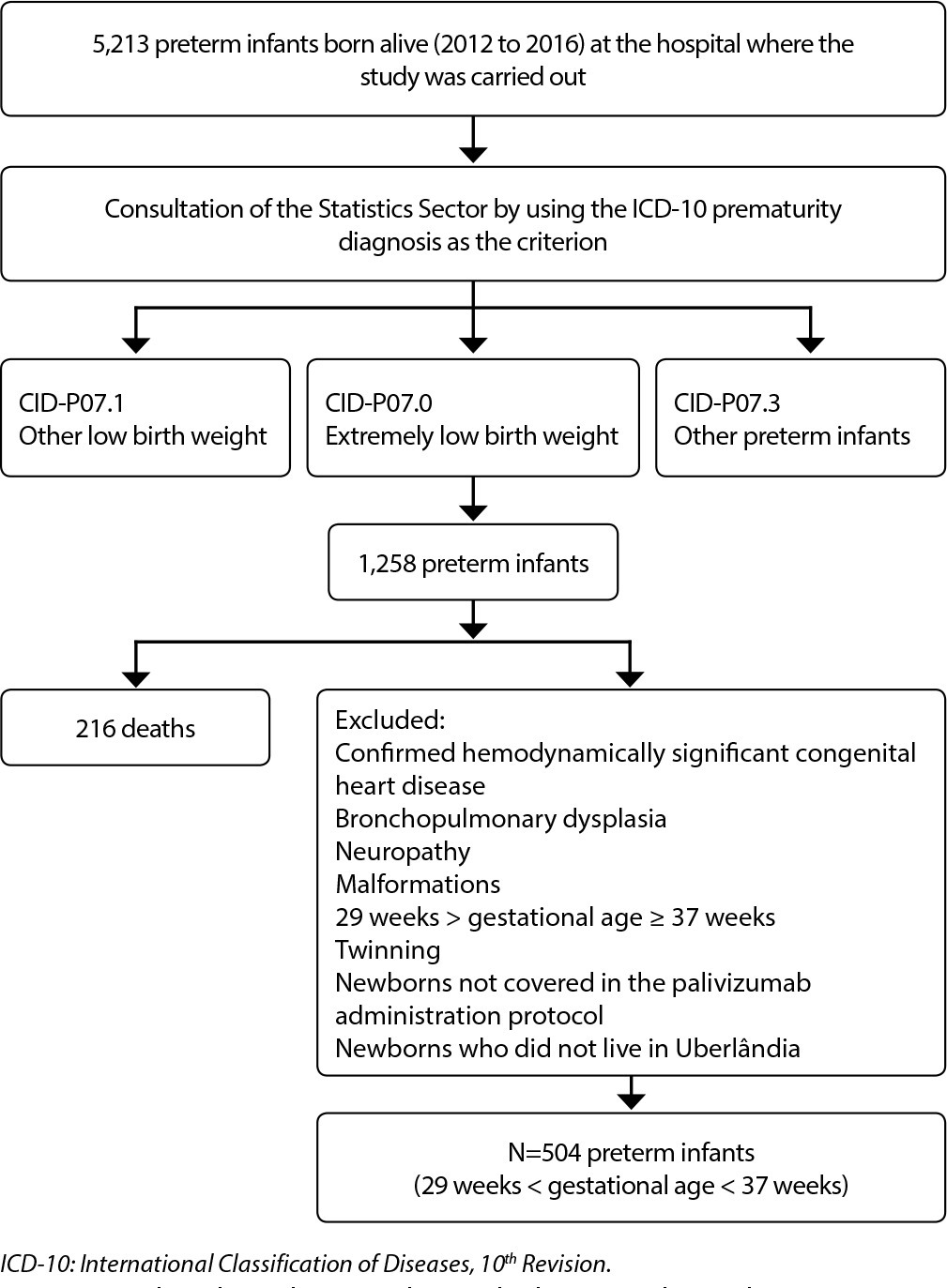
-
ORIGINAL ARTICLE10-03-2022
Instrument validity: HIV and other sexually transmitted infections in homeless people
Revista Brasileira de Enfermagem. 2022;75(6):e20210863
Abstract
ORIGINAL ARTICLEInstrument validity: HIV and other sexually transmitted infections in homeless people
Revista Brasileira de Enfermagem. 2022;75(6):e20210863
DOI 10.1590/0034-7167-2021-0863
Views0See moreABSTRACT
Objectives:
to validate, through the Item Response Theory, an instrument on vulnerability to HIV and other sexually transmitted infections in homeless people.
Methods:
a cross-sectional study carried out between February and May 2018 with 100 homeless people in a municipality in northeastern Brazil. A sociodemographic questionnaire was applied, and another with items referring to behaviors vulnerable to HIV and sexually transmitted infections (STIs). Subsequently, it was assessed through the Item Response Theory.
Results:
the items previous diagnosis of STIs (F=0.473), partner with STI symptoms (F=0.518), drug use (F=0.509), sex for money (F=0.552), STI symptoms (F=0.448), number of sexual partners (F=0.616), sharps sharing (F=0.398) and being a victim of sexual violence (F=0.347) were validated.
Conclusions:
the instrument proved to be validated, being able to identify vulnerability to HIV and other sexually transmitted infections in homeless people.
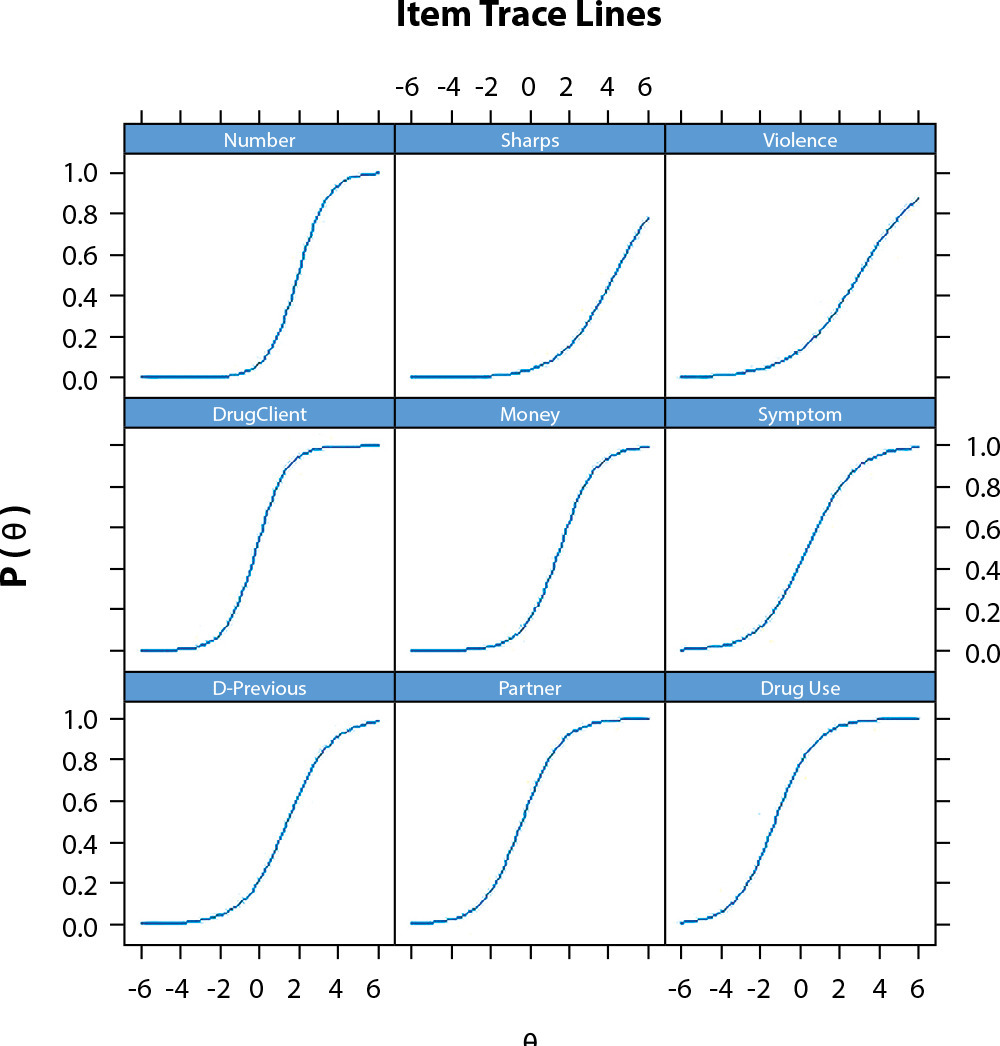
-
ORIGINAL ARTICLE10-03-2022
Good practices in central venous catheter maintenance in time of covid-19: an observational study
Revista Brasileira de Enfermagem. 2022;75(6):e20210397
Abstract
ORIGINAL ARTICLEGood practices in central venous catheter maintenance in time of covid-19: an observational study
Revista Brasileira de Enfermagem. 2022;75(6):e20210397
DOI 10.1590/0034-7167-2021-0397
Views0See moreABSTRACT
Objectives:
to assess adherence to good practices for central venous catheter maintenance by the nursing team during the COVID-19 pandemic.
Methods:
observational, cross-sectional, quantitative research with non-participant observation. Data collection was guided by an instrument developed for this study, consisting of five dimensions. It took place in the intensive care unit of a university hospital in the city of Rio de Janeiro.
Results:
a total of 700 observations were carried out, which resulted, in general, in 402 (57.4%) procedures for adherence to good practices. Hand hygiene (8%) and Performing the dressings (10%) were the dimensions with the lowest adherence.
Conclusions:
good practices for central venous catheter maintenance were partially present in the routine of the nursing team during the COVID-19 pandemic. In critical moments, intensifying the qualification of the teams for a better adaptation to the new work processes is a strategy to sustain the patient safety culture.
-
ORIGINAL ARTICLE10-01-2022
Congenital Zika Virus Syndrome: care in light of the Brazilian Unified Health System principles
Revista Brasileira de Enfermagem. 2022;75(2):e20210146
Abstract
ORIGINAL ARTICLECongenital Zika Virus Syndrome: care in light of the Brazilian Unified Health System principles
Revista Brasileira de Enfermagem. 2022;75(2):e20210146
DOI 10.1590/0034-7167-2021-0146
Views0See moreABSTRACT
Objective:
to know health professionals’ perceptions about care actions provided to children with Congenital Zika Virus Syndrome and their families.
Methods:
this is a qualitative study, carried out in a capital of center-western Brazil, based on the Unified Health System theoretical precepts. Data were collected in September and October 2020, through audio-recorded interviews with 12 health professionals from a specialized service and submitted to analysis of content, thematic modality.
Results:
the implementation of care actions with these children occurs through multidimensional assessment of children and their families, use of the Unique Therapeutic Project, therapeutic interventions for the development of children and the communication and exchange of interprofessional and family experiences, in addition to considering professionals’ prior knowledge and their search for it.
Final considerations:
children with CZS and their families need individualized, frequent, integrated and continuous care.
-
ORIGINAL ARTICLE10-01-2022
Continuity of care for children with special healthcare needs during the COVID-19 pandemic
Revista Brasileira de Enfermagem. 2022;75(2):e20210150
Abstract
ORIGINAL ARTICLEContinuity of care for children with special healthcare needs during the COVID-19 pandemic
Revista Brasileira de Enfermagem. 2022;75(2):e20210150
DOI 10.1590/0034-7167-2021-0150
Views0See moreABSTRACT
Objective:
To describe the continuity of care for children with special healthcare needs during the COVID-19 pandemic through the perception of their caregivers in the Northeast of Brazil.
Methods:
Qualitative descriptive-exploratory research carried out between June and September 2020, in a municipality in the Northeast of Brazil. Eleven caregivers participated through semi-structured interviews conducted at home. The data were submitted to thematic content analysis.
Results:
The social isolation period and the suspension of health services affected the continuity of care, configuring the category “Implications of the COVID-19 pandemic for the continuity of care”. Caregivers expressed fear of children contracting the coronavirus, characterizing the category “Fears and uncertainties of the COVID-19 pandemic in view of the vulnerability of children with special healthcare needs”.
Final considerations:
Caregivers’ reports revealed problems in the continuity of care for the studied cohort. Therefore, health care practices must be rethought in times of pandemic.
-
ORIGINAL ARTICLE10-01-2022
Musculoskeletal symptoms in formal and informal caregivers of elderly people
Revista Brasileira de Enfermagem. 2022;75(2):e20210249
Abstract
ORIGINAL ARTICLEMusculoskeletal symptoms in formal and informal caregivers of elderly people
Revista Brasileira de Enfermagem. 2022;75(2):e20210249
DOI 10.1590/0034-7167-2021-0249
Views0See moreABSTRACT
Objective:
to evaluate musculoskeletal symptoms in formal and informal caregivers of elderly people, and check association with personal and work-related factors.
Methods:
this is a cross-sectional study. Instruments for assessment were the International Physical Activity Questionnaire, Self-Reporting Questionnaire-20, Borg’s effort perception scale and Nordic Musculoskeletal Questionnaire.
Results:
informal caregivers had been working for a longer time (60.2% vs. 41%), had more hours of work (37.4% >12h for day), less time off (85.4% vs. 2.5%) and lack of care guidelines (90.2%). The region with the most musculoskeletal symptoms was the spine and the greater dependence of the elderly, the greater the chances of developing musculoskeletal symptoms (OR= 1.3, 95% CI= 1.1-1.6, p <0.05).
Conclusion:
personal and work-related factors were more prevalent in informal group and the elderly person’s dependence interferes with the increase in musculoskeletal symptoms of caregivers.
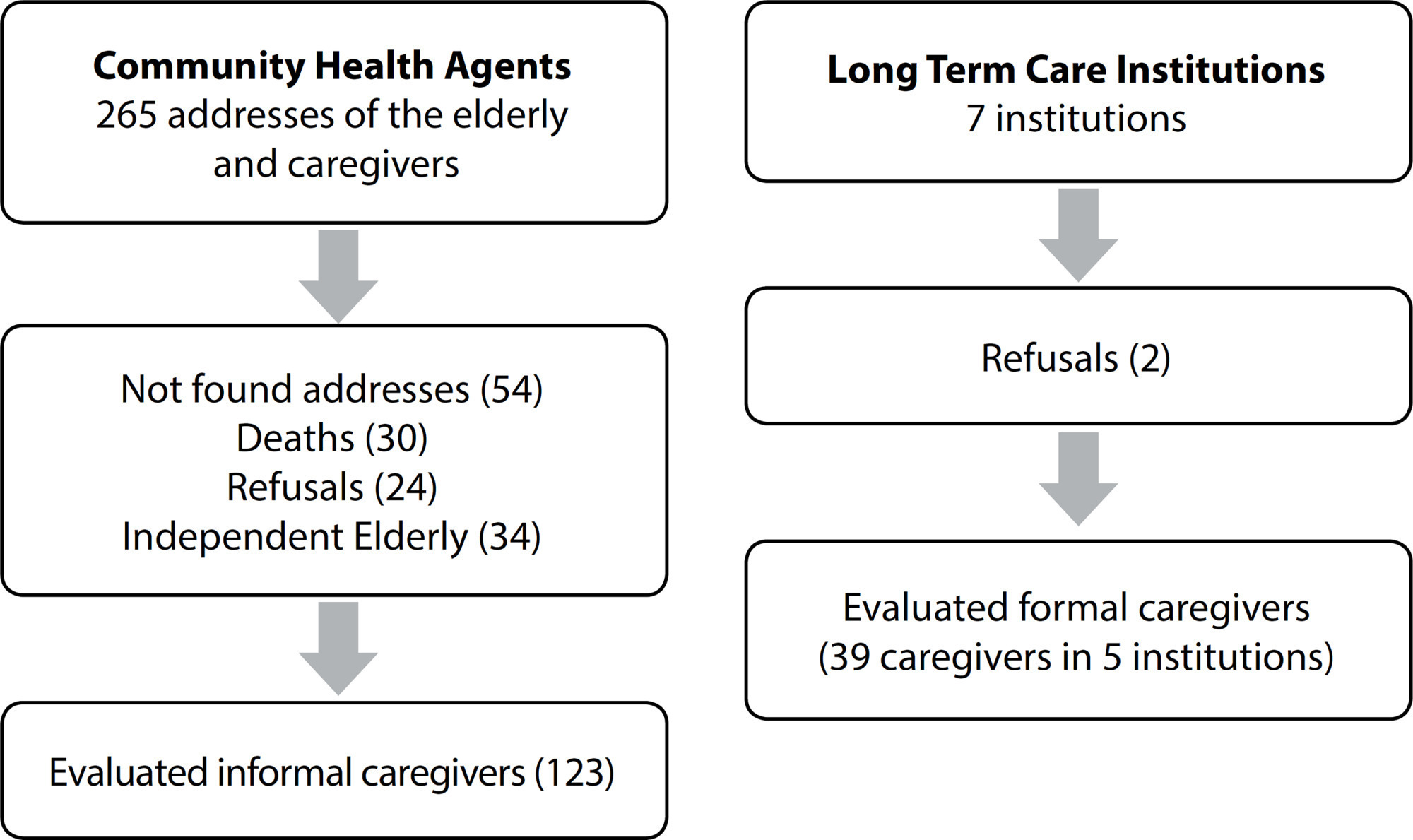
-
ORIGINAL ARTICLE10-01-2022
Coping in mental health during social isolation: analysis in light of Hildegard Peplau
Revista Brasileira de Enfermagem. 2022;75(2):e20201207
Abstract
ORIGINAL ARTICLECoping in mental health during social isolation: analysis in light of Hildegard Peplau
Revista Brasileira de Enfermagem. 2022;75(2):e20201207
DOI 10.1590/0034-7167-2020-1207
Views0See moreABSTRACT
Objectives:
to analyze the coping of individuals in social isolation due to suspicion or confirmation of coronavirus infection from the perspective of Hildegard Peplau’s Theory of Interpersonal Relations.
Methods:
this is a qualitative, descriptive research, carried out with 34 individuals in social isolation due to suspicion or confirmation of coronavirus infection who passed through a screening tent of a university hospital in Paraná. Data were collected through semi-structured interviews in June and July 2020. Empirical categories were interpreted by content analysis.
Results:
four categories emerged: Distance; Social and emotional support; Self-awareness and resolution; Learning. These categories established the coping strategies.
Conclusions:
individuals undergoing social isolation are more likely to present problems related to mental health. It was highlighted that coping strategies, motivated by nurses, anchored in Hildegard Peplau’s theoretical framework, promoted the necessary learning for promoting participants’ mental health in the face of a pandemic context.
-
EXPERIENCE REPORT10-01-2022
Actions of a regulatory nurse in the management of surgical waiting lists
Revista Brasileira de Enfermagem. 2022;75(2):e20201233
Abstract
EXPERIENCE REPORTActions of a regulatory nurse in the management of surgical waiting lists
Revista Brasileira de Enfermagem. 2022;75(2):e20201233
DOI 10.1590/0034-7167-2020-1233
Views0See moreABSTRACT
Objectives:
to describe the actions of the regulatory nurse in the management of waiting lines for elective surgeries in a public hospital.
Methods:
this is an experience report about the actions of the regulatory nurse in the management of waiting lines for elective surgeries.
Results:
the results of this initiative were: diminution in waiting times; elimination of discrepancies that led to access inequality; promotion of safer treatments; actions of the nurse as a manager, conducting and mediating situations between services; autonomy from the high management of the hospital with regard to the manager of waiting lists; and effective communication due to a constant feedback with the medical teams.
Final Considerations:
the management of the surgical waiting lists must be continuous and systematic, and it must be broader, to include teams that are not involved yet. This initiative can be replicated and improved in other health organizations.
-
ORIGINAL ARTICLE08-19-2019
Mobile application for the teaching of the International Classification for Nursing Practice
Revista Brasileira de Enfermagem. 2019;72(4):1020-1027
Abstract
ORIGINAL ARTICLEMobile application for the teaching of the International Classification for Nursing Practice
Revista Brasileira de Enfermagem. 2019;72(4):1020-1027
DOI 10.1590/0034-7167-2018-0751
Views0See moreABSTRACT
Objective:
Developing a mobile application for the teaching of the International Classification for Nursing Practice.
Methods:
Methodological applied research for technological production, performed in three phases of the contextualized instructional design model: analysis, design and development.
Results:
The application has an initial screen, which provides information about the team and its purpose. Then, four moblets are listed, including presentation, user’s guide consisting of five modules, educational games and five clinical cases. The references on which the application was based are also presented.
Final considerations:
It was possible to develop an application with the potential to promote the knowledge of nursing students and professionals about this classification system.
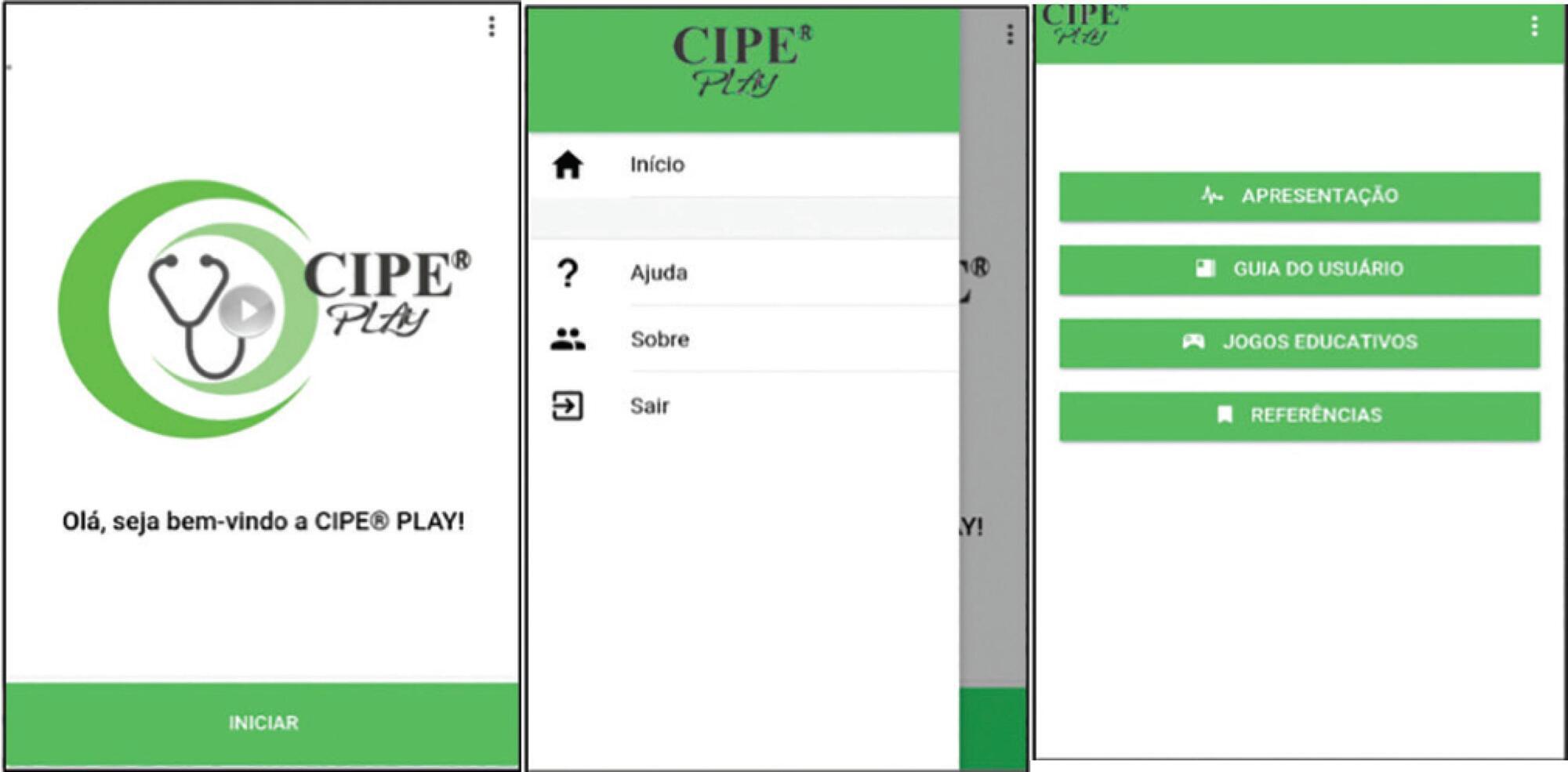
-
ORIGINAL ARTICLE08-14-2020
Education to prevent ventilator-associated pneumonia in intensive care unit
Revista Brasileira de Enfermagem. 2020;73(6):e20190477
Abstract
ORIGINAL ARTICLEEducation to prevent ventilator-associated pneumonia in intensive care unit
Revista Brasileira de Enfermagem. 2020;73(6):e20190477
DOI 10.1590/0034-7167-2019-0477
Views0INTRODUCTIONVentilator-Associated Pneumonia (VAP) is one of the complications related to the care of patients hospitalized in the Intensive Care Unit (ICU), which, according to consulted authors, exceeds the mortality rates of other Healthcare Related Infections (HRI). VAP is the second most frequent infection in patients admitted to the ICU, as well as the most prevalent […]See more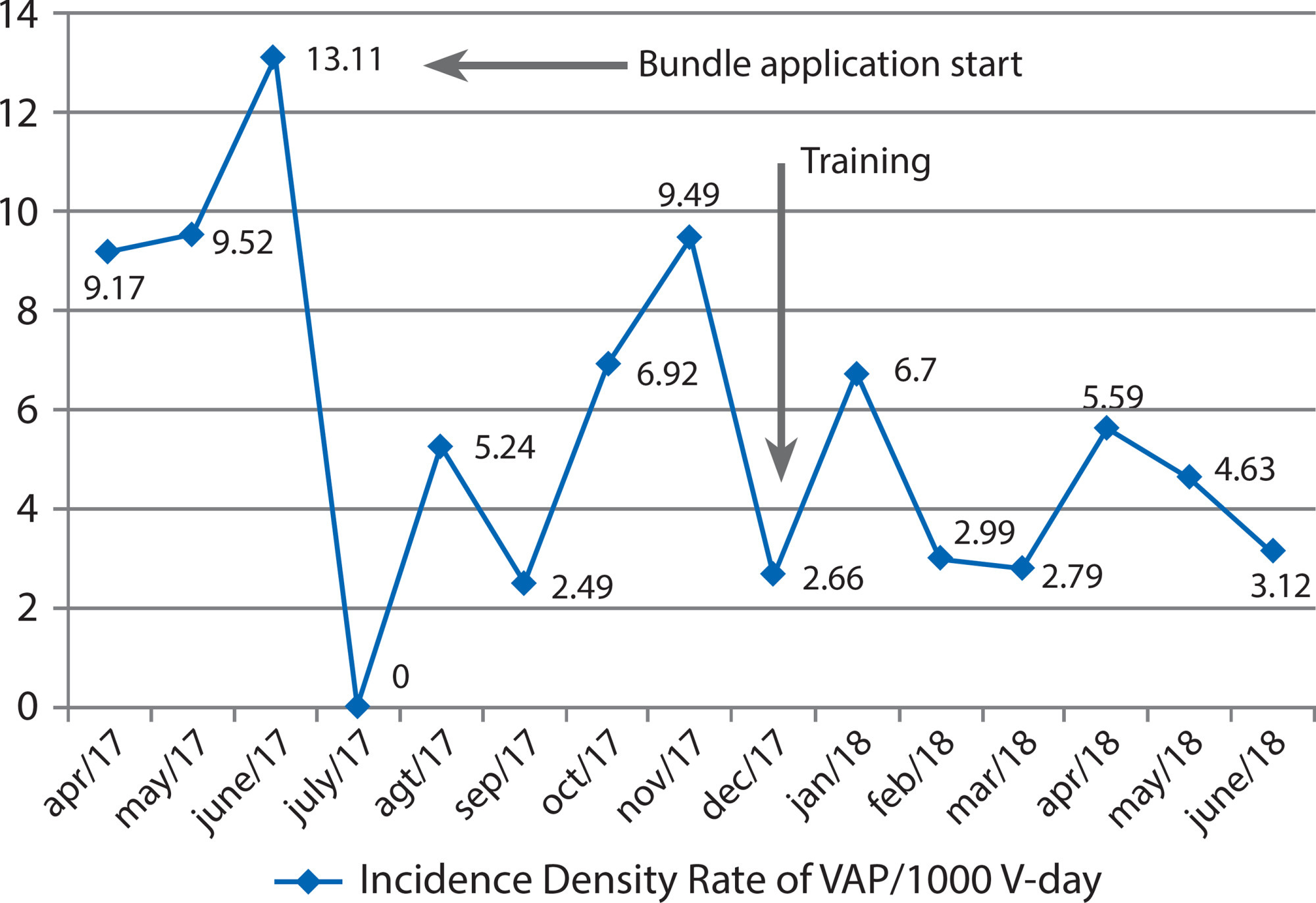
-
08-19-2019
Degree in Nursing: education through problem-based learning
Revista Brasileira de Enfermagem. 2019;72(4):1071-1077
Abstract
Degree in Nursing: education through problem-based learning
Revista Brasileira de Enfermagem. 2019;72(4):1071-1077
DOI 10.1590/0034-7167-2018-0298
Views0See moreABSTRACT
Objective:
To describe how undergraduate courses in Nursing are using the problem-based learning (PBL).
Method:
Integrative literature review, from searches in the databases Education Resources Information Center (ERIC), Latin American and Caribbean Health Sciences Literature (Lilacs), and PubMed, from 2010 to 2015. 36 articles were analyzed.
Results:
A teaching method used in all continents, the PBL enables improvement of the critical thinking, autonomy, motivation for learning, active search attitude, ability to work in teams, and problem-solving. Difficulties and challenges relate to the training of students and teachers to understand the principles of the method.
Final considerations:
The benefits of PBL coincide with the needs of nursing training, but its applicability demands constant review in seeking to develop the skills necessary for this training.
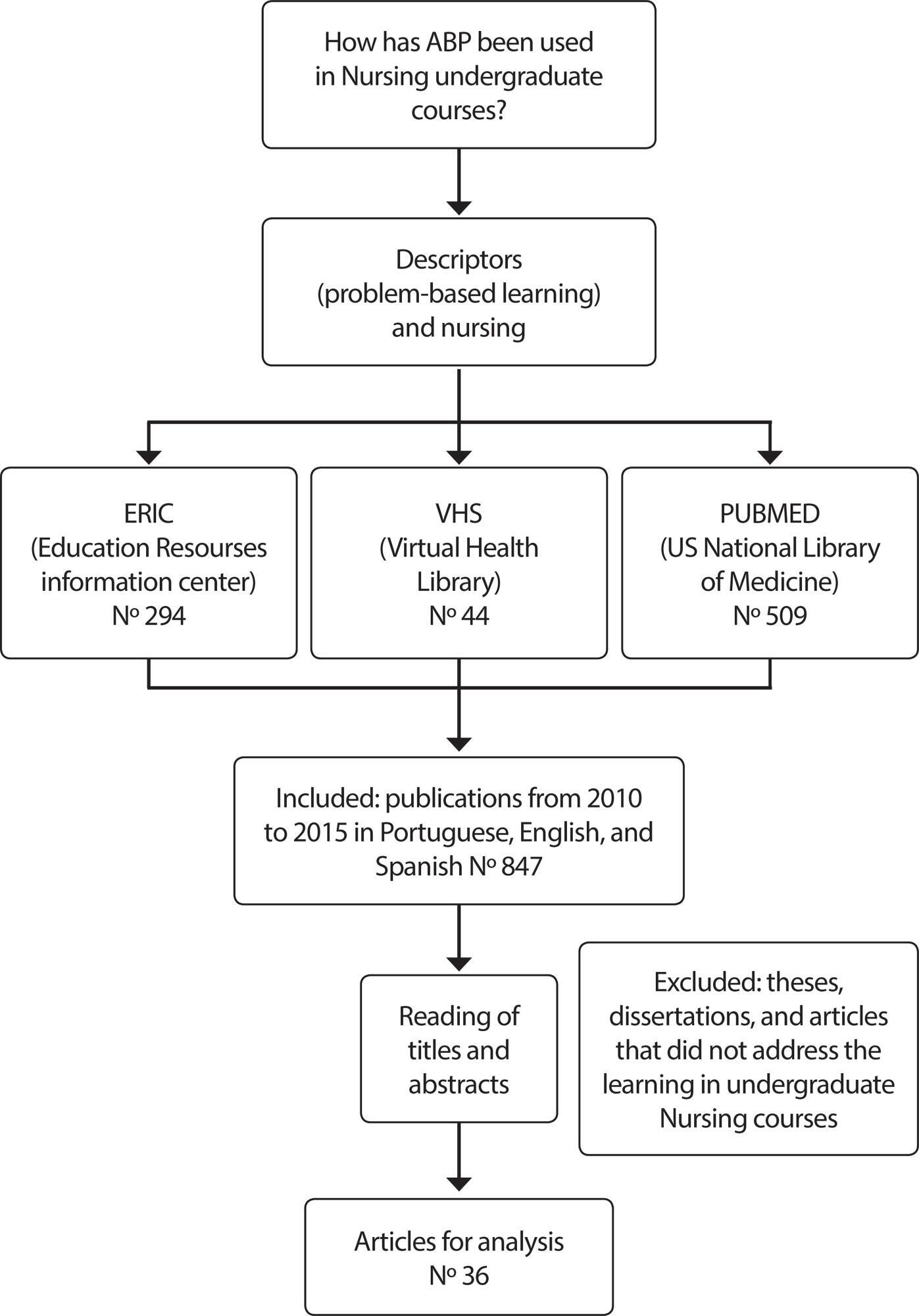
-
ORIGINAL ARTICLE12-13-2019
Mobile health technology for gestational care: evaluation of the GestAção’s app
Revista Brasileira de Enfermagem. 2019;72:266-273
Abstract
ORIGINAL ARTICLEMobile health technology for gestational care: evaluation of the GestAção’s app
Revista Brasileira de Enfermagem. 2019;72:266-273
DOI 10.1590/0034-7167-2018-0641
Views0See moreABSTRACT
Objective:
to evaluate the GestAção application, based on the experience of pregnant women use.
Method:
an evaluative, applied, methodological, quantitative-qualitative study. This tool was evaluated by 13 pregnant women through questionnaires for sociodemographic profile characterization and Likert scale use to calculate Content Validity Index (CVI); and semi-structured interview, with analysis based on Semiotics.
Results:
the study evidenced a significant level of satisfaction of pregnant women with the application use, considering the objectives (CVI = 0.92), structure and presentation (CVI = 0.86), and relevance (CVI = 0.92).
Final considerations:
the GestAção application obtained an overall CVI of 0.90, evidencing it as a facilitating and supporting technology in the empowerment of pregnant women interested in obtaining knowledge about pregnancy. It has been proved to be a powerful tool to qualify good practices in nursing consultation.
-
REFLECTION06-29-2020
Children’s (in)visibility in social vulnerability and the impact of the novel coronavirus (COVID-19)
Revista Brasileira de Enfermagem. 2020;73:e20200302
Abstract
REFLECTIONChildren’s (in)visibility in social vulnerability and the impact of the novel coronavirus (COVID-19)
Revista Brasileira de Enfermagem. 2020;73:e20200302
DOI 10.1590/0034-7167-2020-0302
Views0See moreABSTRACT
Objective:
To examine the impact of the infection by the novel coronavirus on Brazilian children in situation of social vulnerability based on the Millennium Sustainable Development Goals.
Method:
Reflective study based on discursive formulation in three aspects: principles of the objectives and goals for the millennium sustainable development; impact of the pandemic on the health of children and their families living in social vulnerability; and the role of pediatric nursing in the care provided – limits and challenges.
Results:
In January 2020, the news of COVID 19 is released as a pandemic. In Brazil, children and families are still without access to basic rights, thereby increasing their risks of social vulnerability because of the quarantine. The nursing field has an important role in monitoring children and their families, offering guidance in search for solutions and preventing contamination.
Conclusion:
There are still challenges to be overcome by the children and their families in situations of vulnerability against COVID-19.
-
ORIGINAL ARTICLE07-10-2020
Profile of nursing students: quality of life, sleep and eating habits
Revista Brasileira de Enfermagem. 2020;73:e20190365
Abstract
ORIGINAL ARTICLEProfile of nursing students: quality of life, sleep and eating habits
Revista Brasileira de Enfermagem. 2020;73:e20190365
DOI 10.1590/0034-7167-2019-0365
Views0See moreABSTRACT
Objective:
to profile and analyze sleep quality, quality of life and eating habits of nursing students.
Methods:
a cross-sectional, comparative and correlational study with the following variables: sociodemographic characteristics, Pittsburgh sleep quality index, quality of life and eating habits. One hundred ninety-five students participated in the study.
Results:
participants were on average 24 years old. Results showed that females were prevalent (87.1%); 71.0% of the students had poor sleep quality; 98.9% used electronic devices before bedtime. Self-perception of quality of life was indifferent (38.3%), and self-perception of general health, 36.9% expressed satisfaction. Among the participants, 45.13% consumed one portion of fruit and 40.66% two to three portions of vegetables daily.
Conclusion:
the study allowed the profile of these students, sedentary, overweight and poor sleep quality young students who studied and worked.
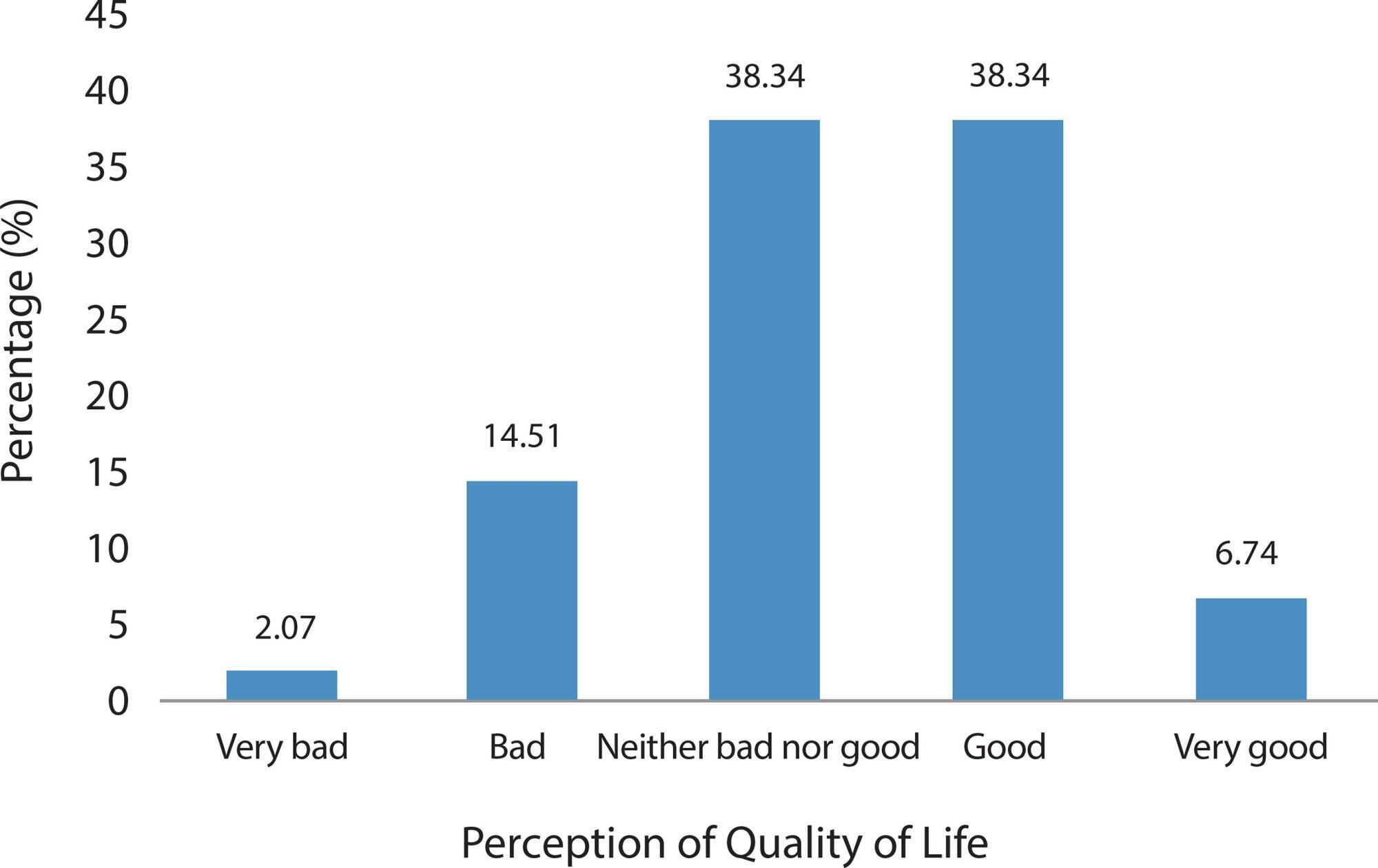
-
ORIGINAL ARTICLE06-09-2020
Stress of nursing professionals working in pre-hospital care
Revista Brasileira de Enfermagem. 2020;73(2):e20180660
Abstract
ORIGINAL ARTICLEStress of nursing professionals working in pre-hospital care
Revista Brasileira de Enfermagem. 2020;73(2):e20180660
DOI 10.1590/0034-7167-2018-0660
Views0See moreABSTRACT
Objectives:
To analyze the factors related to the occupational stress of a Mobile Emergency Care Service (Samu) nursing team.
Methods:
This is a descriptive study, with a quantitative approach, performed with nursing professionals from Samu service of a city of Pernambuco. A sociodemographic questionnaire and the Lipp’s Stress Symptom Inventory were used.
Results:
The participants presenting stress (24.6%) were classified in the phases: resistance (19.7%), exhaustion (4.4%) and near exhaustion (0.5%). It was also observed an association of stress level with the following factors: gender, sleep quality, professional autonomy restriction, emotional exhaustion with work performed and work in inadequate or unhealthy physical facilities.
Conclusions:
Although showing low occurrence of stress, this study pointed out the profile that presents the highest risk of developing occupational stress, through the factors significantly associated with stress in the studied population.
-
ORIGINAL ARTICLE07-10-2020
Nursing appeals on social media in times of coronavirus
Revista Brasileira de Enfermagem. 2020;73:e20200225
Abstract
ORIGINAL ARTICLENursing appeals on social media in times of coronavirus
Revista Brasileira de Enfermagem. 2020;73:e20200225
DOI 10.1590/0034-7167-2020-0225
Views0See moreABSTRACT
Objective:
to know and analyze the nursing appeals on social media during the COVID-19 pandemic.
Method:
it is a documentary, qualitative, descriptive, and exploratory research with data collected in publications in two social media. Two hundred ninety-five publications of nursing professionals published on Twitter and Instagram between March 11 and 20, 2020 were submitted to content analysis using ATLAS.ti resources.
Results:
four thematic categories emerged: #stayathome, #whereismyPPE, #nowweareheroes, #nothingnewinthefrontline, according to frequency of communications. The appeals show a relationship with the social relevance of nursing professional work and with the conditions required for its exercise.
Final considerations:
old and new challenges of the profession were placed on the agenda in social media, especially related to the workforce and instruments of labor. These speeches can serve as a foundation for policies to improve working conditions and promote appreciation of the profession.

Search
Search in:
Nuvem de Tags
Adolescente (85) Atenção Primária à Saúde (239) COVID-19 (91) Criança (91) Cuidados de Enfermagem (269) Educação em Enfermagem (151) Educação em Saúde (139) Enfermagem (930) Enfermagem Pediátrica (86) Estudantes de Enfermagem (77) Estudos de Validação (131) Família (87) Idoso (208) Promoção da Saúde (99) Qualidade de Vida (104) Saúde do Trabalhador (86) Saúde Mental (145) Saúde Pública (82) Segurança do Paciente (150) Tecnologia Educacional (100)



